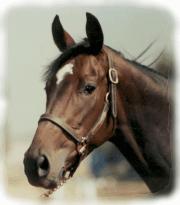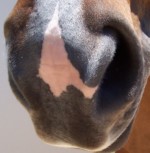A Horse, of Course with Don Blazer |
If you enjoy learning about horses, then you'll love our online courses. Each month you'll find a new column on our web site. We hope you'll enjoy it, and maybe e-mail us with questions or suggestions for other columns. A Horse, Of Course is a monthly column syndicated by Success Is Easy. If you like the column, call your local newspaper, or local horse publication and ask them to subscribe by contacting Success Is Easy. |
The Equine Nose Don Blazer copyright©2012 |

The nostrils you see form the entrances to the upper airway and are kept open by cartilaginous insertions in the soft tissue under the skin. Muscular attachments control the extent of the openings. When there is a need for a lot more air, the nostril you see is expanded by the lifting of a fold within the nostril…this fold is the “false nostril.” In addition to aiding in the expansion of the seen nostril, the “false” nostrils serve to warm the air before it is drawn into the lungs. It is the “false” nostrils which allow the horse to snort and make that loud vibrating nose when he is galloping along. Of course a horse uses his nose to smell. How keen his sense of smell is hard to tell….but it’s easy to tell he likes some smells and doesn’t like others. Offer water from a different supply and see how quickly he can sniff it and decide not to drink it. We know a horse sniffs another horse when making his acquaintance; mostly, however, they blow into each other’s nostrils. But a horse seldom just smells; he uses his senses of sight and hearing in cooperation with his sense of smell. The most important function of the nose, of course, is for breathing. A horse doesn’t breathe through his mouth; he always breathes through his nose. Large, thin-walled nostrils allow for great expansion when exercising extensively and there is a requirement for lots of air. Horses bred for slower types of work have smaller, thicker-walled nostrils. When examining a horse, look carefully at the nostrils. At rest the movement of the nasal opening should be even. There should be nothing spasmodic about the movement. When the horse is stressed (worked) the nostrils should expand and the expansion should be even rather than a sudden jerking open. Horses are subject to nosebleeds, both from external trauma and from the rupture of delicate interior membranes. Internal nosebleeds are known as “epistaxis” and are generally not too serious. Dusty, dry feed can cause a slight inflammation in the nostrils leading to nosebleed. The thing horses probably do most obviously with their noses is “poke them into other people’s business”. No matter the breed, sex or age of a horse, you’ll find more often than not that he has his nose somewhere it doesn’t belong. His nosy tendency goes back to his natural curiosity, and the fact that if he is going to look or listen, he is also going to smell. For a horse, nose news is important news. |
Who knows much about a horse’s nose? Most horse lovers don’t pay much attention to the horse’s nose. When they do, it is too often a girl kissing the horse’s nose---a very dangerous and silly thing to do. That may be a little hard-nosed, but it’s true. I know that horses are pretty nosy. I know that the Daily Racing Form writes more about horses’ noses than any other publication. Of course the Daily Racing Form is wrong when it reports the horse “won by a nose.” |

Horses actually win races by “an upper
lip.” The horse’s upper lip gets to the finish line before the nose.
I know that horses’ noses are a little deceitful. You don’t see all that’s there. There aren’t just two nostrils; there are four. |